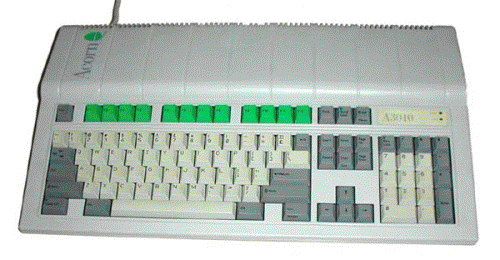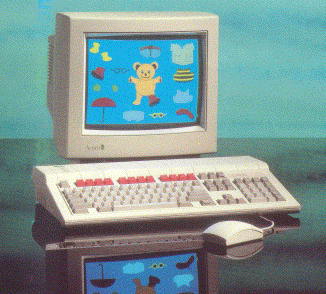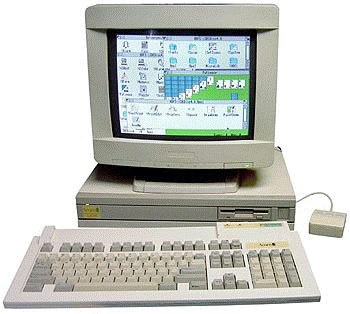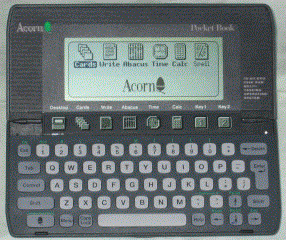



Acorn's new releases for 1992
The RISC OS time machine goes back to the heydays of Acorn's RISC OS hardware...
Facts and first impressions from Mark Moxon and Mike Williams.
Acorn Computers has announced a wealth of new products for the autumn, and while there may be no major surprises or revolutionary developments, the impact of the new product range on the consumer and educational computer markets could be considerable. In this month's five page feature we focus on the more significant of the new releases. We will also be reporting in much more detail on these products in future issues of RISC User.
Foremost among the new products is a range of new A3000 systems: the A3010 targeted firmly at the consumer market, and the A3020 version aimed squarely at educational users, both in a number of different packages. The new A4000 provides similar package to the A3020 but in a three-box A5000 style arrangement. All these systems feature a new ARM250 chip. Acorn has also upgraded the A5000, the present model being replaced by two new versions: the A5000 2MB HD80 and the A5000 4MB HD120, with 80Mb and 120Mb hard discs respectively. The new HD80 version is £100 less than the original A5000, and the HD120 model with 4Mb of RAM weighs in at just £1599 ex. VAT.
All the new systems referred to above come complete with RISC OS 3.10, and this version of RISC OS is now available to all existing Archimedes users as an upgrade. The new style mouse, introduced on the A4, is now standard on all systems.
Acorn has also announced a new networking standard, AUN (Acorn Universal Networking), as part of its move towards adopting the Ethernet standard for all RISC OS systems, while still maintaining compatibility with its own low cost Econet network.
Finally, Acorn has also announced a completely different machine, the Acorn Pocket Book, based substantially on the Psion series 3, but with Acorn specified software. This costs around £200.
Details of all these new releases are covered in the following pages. All new products, including RISC OS 3.10 upgrades, are scheduled to be available from the beginning of September.
Acorn's New A3000 Range and A4000
Amongst the wealth of new products released by Acorn this autumn, the updated, revitalised A3000 series (plus the A4000) must be the most important and significant development. However, the range of new machines may seem confusing at first, so let's see what is happening.
The ARM250
At the heart of the new A3000 range is the ARM250. This is an integrated chip comprising ARM2 processor, VIDC (video controller), MEMC (memory controller), IOC (input/output controller), and PC bus interface (previously a set of four separate chips). The processor operates at 16MHz with a performance of around 7MIPS. ARM Ltd., the designers, claim that the ARM250 offers performance 1.4 times that of a 386DX running at 33MHz. The ARM250 thus clocks in somewhere between the ARMS at 4MIPS and the ARM3 rated at 13MIPS.
The ARM250 is based on four ARM macrocells (ARMS CPU, MEMC1, VIDC1, IOC1) providing a direct interface to DRAM (dynamic RAM) and ROM with support for memory mapping and protection, bitmapped displays with integral palette, and on-board video and stereo sound digital to analogue converters (DACs). ARM Ltd. says that the ARM250 has been developed as a direct response to Acorn's need for a low cost power house for its new machines.
Motherboard
All the new A3000 style systems use the ARM250 mounted on a newly designed and sparsely populated motherboard. The new board design accommodates the power supply as well as all interfaces (including a single mini-expansion slot), and fits in a totally new style of casing (see illustration). All the connections fit along the rear (see fig. 1), with a high density floppy disc drive mounted to the right (seen from the front), and a recessed reset button to the left. The entire system is now fully screened to meet international standards on interference from RF radiation, but this does, of course, add to the weight.
The new ARM250 models
There are essentially three different ARM250 models, with a number of variants in each case. The A3010 and A3020 share the same new style case (combining motherboard and keyboard). The A4000 has the same components but is packaged up as a three box system (similar to the A5000). All models run RISC OS 3.10, and thus provide the same powerful Desktop environment as the A5000.
The A3000 systems
The A3010 is the new consumer model, and is finished in a warm grey case with green function keys - the result, apparently, of Acorn's market research. This model features 1Mb of RAM (upgradable to 2Mb) and comes with twin joystick ports (suitable for standard Commodore and Atari style switch joysticks). The A3010 also has a built-in TV modulator. It has no hard disc interface, but an IDE or SCSI hard drive could be added in conjunction with a suitable interface.

This machine is being sold in two packages. The Family Pack comprises an A3010 with software pack including Minerva's Easiword word processor. Quest for Gold (game) and supporting audio cassette tapes at just £499 inc. VAT. The Learning Curve version provides the same machine and software as above, but also adds the Genesis Collection, the PC Emulator (now called PCSoft) and DR DOS 6, together with an Acorn standard colour monitor (with a new tilt and swivel base) all for £799 inc. VAT.
The new A3020 uses the same casing as the A3010, but in cream with red instead of green function keys. It has 2Mb of memory expandable to 4Mb, built in IDE hard disc controller, and a new standard networking socket in place of the twin joystick ports of the A3010. Missing is the TV modulator of the A3010.

Acorn says this system has been designed primarily for the needs of the educational market. It will be available in two versions, with and without a 60Mb hard disc drive. It will again be supplied with an Acorn standard monitor, but a multiscan monitor will be an alternative for an extra £50 (plus VAT).
Acorn also says that the existing A3000 will continue to be supplied "while there is demand" (at the new price of £525 ex. VAT), but it seems very likely that the attractions of the new machines will rapidly cause the demise of the old A3000. This system's only merit, in comparison with the new machines, is that it can be upgraded with the faster ARM3 processor, but it doesn't have the high density floppy drive of the new systems, or the new networking capability.
The A4000
The last model to be launched as part of this series (though it is something of a hybrid) is the A4000. This packages an A3020 in a three box configuration, like the A5000. The motherboard fits in a slim height A5000 style case, and has a separate keyboard similar to but not identical to that of the A5000. The A4000 is also supplied with an 80Mb hard drive, instead of the A3020's 60Mb unit.

Acorn says that this system is particularly aimed at the needs of secondary schools who prefer the industry standard three box approach to their computing needs, rather than the A3000 style. The A4000 is certainly an attractive and slim looking system, but it has no more expansion capability than the A3020, so no ARM3, and no expansion other than the single mini-expansion slot. There is also an A4000 Home Office package with EasiWriter word processor. Desktop Database and optional inkjet printer.
With five different systems now slotted in below the higher specification A5000, Acorn now has a highly competitive range of 32-bit systems, and should be well placed to attack both its traditional educational and enthusiast market, as well as the mass consumer markets through stores such as Dixons and Argos.
RISC OS 3
The new Acorn operating system, RISC OS 3 version 3.10, is now available for all Acorn RISC machines. For more information on RISC OS 3, we refer you to RISC User Volume 5 Issues 1,2 and 3.
RISC OS 3 version 3.10 does have a few improvements over version 3.00, and a number of bugs have been fixed. The good news for ARMS owners is that the system has been optimised to run much faster, and Acorn say RISC OS 3 should run just as fast as RISC OS 2. The RISC OS 3.10 upgrade is available in four different packages, as follows.
- The upgrade kit for RISC OS 2 users officially costs £89 inc. VAT, but will be available at the special price of just £49 inc. VAT until the middle of next year. The kit consists of a new chip set, the new manuals, the RISC OS 3 discs, an audio tape and a set of release notes. The two RISC OS 3 guides are now sandwiched together into one manual, bound conventionally rather than ring bound.
- The upgrade kit for A5000 users costs £19 inc. VAT, and simply consists of the new chip set and discs. This price is at cost price to Acorn.
- Educational users can buy a bulk upgrade for ten stations for £399 inc. VAT. For this they receive ten chip sets, one set of manuals and one set of discs.
- Finally an adaptor set to enable the old A300s and A440s to take the new ROMs is available for £30 inc. VAT and fitting (in addition to the normal upgrade cost). Again, this is at cost price to Acorn.
Acorn has managed to make RISC OS 3 available to existing users much more cheaply than we feared. All users should consider upgrading as soon as possible, and all upgrades are available through dealers (including Beebug, of course).
The Acorn Universal Networking Strategy
The new Acorn A3020 and A4000 computers have a feature that will be of great interest to network users. The old 5- pin DIN Econet socket has disappeared, to be replaced by a new 15-pin D-type socket. The internal network circuitry has also been redesigned to provide a completely new approach to networking, which is all a part of Acorn's new philosophy, the Acorn Universal Network, or AUN for short.
Since the dawn of the BBC micro era, Acorn has promoted its proprietary and economically priced Econet system as the network to use. The main alternative to Econet is the industry standard Ethernet, which is much more expensive, but can carry data at speeds of 10Mbits per second - about 50 times the speed of Econet.
Until now the only way to connect an Acorn RISC machine to an Ethernet was to add a separate Ethernet podule. However, the new internal design of the A3020 and A4000 enables a whole variety of cards to be plugged straight in, permitting connections to all sorts of network. Currently the only cards available are for Econet and Ethernet, but the system is flexible enough to enable cards for any network to be designed. This redesign means that the old Econet cards will not fit the new machines, but the cost of the redesigned Econet upgrade is expected to be the same. Although the network socket is different to the old sockets, a new cable allows connection to an existing Econet network.
As an indication of their commitment to networking. Acorn has also released two A5000 models without hard discs. The A5000 ES (£1299 ex. VAT) has a built-in Econet interface, and the A5000 NS (£1399 ex. VAT) has a built-in Ethernet interface.
So, Acorn machines can now easily be connected to both Econet and Ethernet networks, but there is no comprehensive method for connecting the two different types of network together. This is where AUN comes in.
The first product to include specific AUN software is the AUN Level 4 Fileserver Release 2, costing £399 ex. VAT. This new release of the fileserver software (which simply turns a networked computer into a fileserver without the need for additional hardware) will now allow fileservers to be hooked into a much larger network system, which can contain many different types of network. Fileservers linking Econet and Ethernet networks act as gateways between the two types of network, simply by running AUN.
A complete AUN consists of a main Ethernet backbone network, to which any number of independent network clusters can be connected. Ethernet clusters can be connected to the backbone directly, and Econet clusters are connected via gateway fileservers. The clever part is that every station on every cluster will be able to access every fileserver on every other cluster, and these will appear to the user as normal storage device icons on the icon bar, regardless of whether the fileserver being accessed is on Ethernet or Econet. The system is very simple to use, and all this is done invisibly as far as the user is concerned.
On top of all this. Acorn's TCP/IP software can be installed on any RISC OS machines to allow them to communicate with non-RISC OS based fileservers, such as PCs, Apples or Unix systems. Thus an Econet network can be connected to an Ethernet with Unix fileservers, and all RISC OS computers running TCP/IP on the Econet network will be able to access the Unix fileserver directly.
These exciting developments massively extend the potential connectively of Acorn machines, while retaining compatibility with the older Econet standard.
The Acorn Pocket Book
The Acorn Pocket Book is a very small, hand-held computer, based on the Psion Series 3 portable organiser. The software included in the Pocket Book has been specially created to fit in with Acorn's guidelines, and a link system has been devised to enable the Pocket Book to integrate with the RISC OS Desktop; this means the Pocket Book simply appears as a separate filing system on the hosts's icon bar.

The resident software that is built in to the Pocket Book consists of Write (a word processor with spelling checker). Abacus (a spreadsheet). Cards (a database). Time (clock and alarm) and Calc (a scientific calculator). The operating system, which is Psion's standard Series 3 OS, is multi-tasking, and allows the user to switch between the various tasks at will. There is 256K of RAM, and so-called Solid State Discs (SSDs) optionally provide up to 4Mb of additional data storage There are two types of SSD that can be used. Flash SSDs require no battery backup, but deleted files still take up memory, and RAM SSDs have their own lithium battery to keep data stored. The two standard AA batteries used by the Pocket Book last for about 80 hours of active computing, or a separate mains adaptor can be used.
There is also a programming language called OPL, which can be used to write applications on the Pocket Book. The OPL editor, used to write OPL programs, is available only as a separate product - just the run-time system is provided as standard.
Acorn hopes the Pocket Book will be bought by schools to enable pupils to collect data out in the field and process it in the classroom. It also hopes that concerned parents will invest in Pocket Books for their children, as at £249.95 inc. VAT (£199 ex. VAT to education) they are quite a lot cheaper than full Acorn RISC computers. We will have to wait and see.
The New Product Range
The following is a list of all new or repriced Acorn computer products, but does not show the whole Acorn range. Prices shown VAT, and educational prices are shown in brackets where applicable.
| A3000 1Mb FD | £525.00 (£475) |
| A3010 1Mb FD Family Solution | £424.68 |
| Colour monitor for A3010 | £220.00 |
| A3010 1Mb FD Learning Curve, inc. colour monitor | £680.00 |
| A3010 2Mb FD Colour | £749.00 (£649) |
| A3010 2Mb FD Multiscan | £799.00 (£699) |
| A3020 2Mb HD60 Colour | £899.00 (£799) |
| A3020 2Mb HD60 Multiscan | £949.00 (£849) |
| A4000 2Mb HD80 Colour | £949.00 (£849) |
| A4000 2Mb HD80 Multiscan | £999.00 (£899) |
| A4000 Home Office Colour | £999.00 |
| A4000 Home Office Multiscan | £1049.00 |
| A5000 2Mb HD80 Multiscan | £1399.00 (£1199) |
| A5000 2Mb HD80 Learning Curve | £1445.96 |
| A5000 4Mb HD120 Multiscan | £1599.00 (£1399) |
| A5000 ES (Econet) | £1299.00 (£1149) |
| A5000 NS (Ethernet) | £1399.00 (£1249) |
| A540 4MB HD120 (no monitor) | £1995.00 (£1699) |
| Acorn Pocket Book | £212.72 (£199) |
Foundation RISCWorld